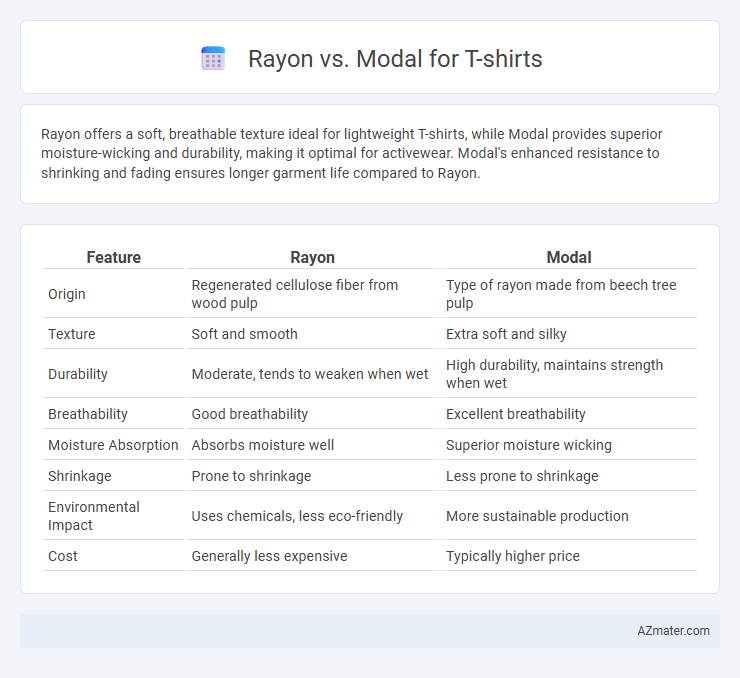Rayon offers a soft, breathable texture ideal for lightweight T-shirts, while Modal provides superior moisture-wicking and durability, making it optimal for activewear. Modal's enhanced resistance to shrinking and fading ensures longer garment life compared to Rayon.
Table of Comparison
| Feature | Rayon | Modal |
|---|---|---|
| Origin | Regenerated cellulose fiber from wood pulp | Type of rayon made from beech tree pulp |
| Texture | Soft and smooth | Extra soft and silky |
| Durability | Moderate, tends to weaken when wet | High durability, maintains strength when wet |
| Breathability | Good breathability | Excellent breathability |
| Moisture Absorption | Absorbs moisture well | Superior moisture wicking |
| Shrinkage | Prone to shrinkage | Less prone to shrinkage |
| Environmental Impact | Uses chemicals, less eco-friendly | More sustainable production |
| Cost | Generally less expensive | Typically higher price |
Introduction to Rayon and Modal Fabrics
Rayon is a semi-synthetic fiber made from regenerated cellulose, known for its smooth texture and breathability, making it a popular choice for breathable T-shirts. Modal fabric, a type of rayon derived specifically from beech tree pulp, offers enhanced softness, durability, and better moisture-wicking properties compared to regular rayon. Both fabrics provide comfort and a silky feel, with modal often preferred for higher-quality T-shirts due to its improved performance and eco-friendly production.
What Is Rayon? Key Characteristics
Rayon is a semi-synthetic fiber made from regenerated cellulose, primarily sourced from wood pulp, offering a soft, breathable, and lightweight fabric ideal for T-shirts. Key characteristics include excellent moisture absorption, a smooth texture similar to natural fibers, and good drape, making it comfortable for everyday wear. Despite its delicate nature, rayon provides vibrant color retention and a silky feel, distinguishing it from other T-shirt fabrics like modal.
What Is Modal? Key Characteristics
Modal is a type of semi-synthetic fabric made from beech tree pulp, known for its exceptional softness and breathability, making it ideal for T-shirts. It exhibits excellent moisture-wicking properties, resists shrinkage, and maintains color vibrancy even after multiple washes. Compared to regular rayon, Modal offers enhanced durability and a smoother, silk-like texture that improves comfort and wearability.
Comparison of Softness and Comfort
Modal fabric offers superior softness compared to rayon, owing to its finer fibers and smoother texture, making it ideal for T-shirts worn close to the skin. Rayon, while soft, tends to be less smooth and can sometimes feel heavier, affecting overall comfort during extended wear. Modal also excels in moisture-wicking and breathability, enhancing comfort in comparison to conventional rayon materials.
Breathability and Moisture-Wicking Abilities
Modal fabric offers superior breathability and moisture-wicking abilities compared to rayon, making it ideal for T-shirts worn in warm or active conditions. Modal's fibers are more absorbent, allowing them to draw moisture away from the skin quickly, enhancing comfort and reducing sweat buildup. Rayon, while breathable, tends to retain moisture longer, which can lead to a damp and less comfortable wearing experience during intense physical activity.
Durability and Longevity: Which Lasts Longer?
Modal fabric generally offers greater durability and longevity for T-shirts compared to rayon due to its higher resistance to shrinkage, pilling, and fading over multiple washes. Rayon, while soft and breathable, tends to lose shape and weaken more quickly, especially under frequent laundering and wear. Choosing modal ensures a longer-lasting T-shirt that maintains its quality and appearance over time.
Environmental Impact: Rayon vs Modal
Rayon production involves significant chemical processing and deforestation, contributing to higher environmental degradation compared to Modal, which is made from sustainably sourced beechwood and uses a closed-loop process that recycles most chemicals and water. Modal fibers have a lower carbon footprint and biodegrade more quickly, making them a more eco-friendly choice for T-shirts. Choosing Modal over Rayon reduces water consumption and minimizes toxic waste, supporting sustainable fashion practices.
Care Instructions: Maintenance Differences
Rayon T-shirts require gentle hand washing or machine washing on a delicate cycle with cold water to prevent fabric weakening and shrinkage, while Modal T-shirts are more durable and can generally withstand machine washing on warm or cold settings without significant damage. Avoid using bleach or harsh detergents on both Rayon and Modal to maintain fabric softness and color integrity. Air drying or tumble drying on low heat is recommended for Rayon, whereas Modal is more resistant to shrinkage and can handle low to medium heat drying safely.
Price Comparison for T-Shirts
Rayon T-shirts generally cost less than Modal T-shirts due to the simpler manufacturing process of rayon fibers derived from cellulose. Modal fabric, known for its superior softness and durability, often commands a higher price point in the market, reflecting its premium quality and eco-friendly production methods. Consumers seeking budget-friendly options typically choose rayon, while those prioritizing comfort and longevity invest in Modal T-shirts despite the higher cost.
Which Fabric Is Better for T-Shirts?
Modal fabric offers superior softness and moisture-wicking properties compared to rayon, making it more comfortable for T-shirts. Rayon is breathable and affordable but tends to shrink and lose shape after washing, whereas modal retains durability and vibrant color longer. For premium, long-lasting T-shirts, modal is generally the better fabric choice.

Infographic: Rayon vs Modal for T-shirt
 azmater.com
azmater.com